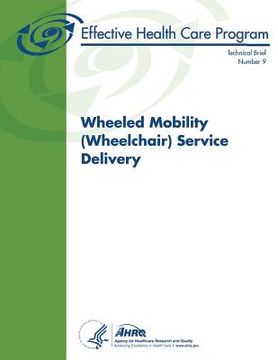Wheeled Mobility (Wheelchair) Service Delivery: Technical Brief Number 9 (en Inglés)
Reseña del libro "Wheeled Mobility (Wheelchair) Service Delivery: Technical Brief Number 9 (en Inglés)"
Wheeled mobility or wheelchair use in the U.S. is at an all-time high and growing. A 2005 survey of noninstitutionalized Americans estimated that approximately 3.3 million people (1.4 % of the population) 15 years of age and older used a wheelchair or similar device. Of those 3.3 million, approximately 1.8 million were 65 years and older (5.2 % of that population). Among children under 15 years of age, an estimated 83,000 used a wheelchair or similar device (0.2 % of that population). A similar survey conducted in 2002 estimated use at 1.2 % of the population 15 years and older, 4.5 % of the population 65 years and older, and 0.2 % of the population under 15 years of age. An earlier survey (1994-1995 data) of noninstitutionalized individuals in the U.S. estimated that there were 1.6 million (0.6 %) wheelchair users of all ages including 88,000 under age 18 years (0.12 %) and 897,000 (2.87 %) 65 years of age and older. Of the total group of wheelchair users, 1.5 million used manual wheelchairs and 155,000 used electric wheelchairs. The leading conditions associated with wheelchair use included stroke, osteoarthritis, multiple sclerosis, absence or loss of lower extremity, paraplegia, orthopedic impairment of lower extremity, heart disease, cerebral palsy, rheumatoid arthritis, and diabetes. At the same time that the population of mobility-impaired individuals is growing, advances have been made in mobility device and component technology. Although difficult to quantify, there appears to be increased use of power mobility devices, including power wheelchairs and scooters or power-operated vehicles. Advances in wheeled mobility offer enhanced functionality. Mobility devices have been shown to increase the activity, participation, and quality of life of individuals with mobility limitations. The degree to which these wheeled mobility devices and components (notably postural seating and positioning systems) contribute to quality of life depends on the appropriateness of the wheeled mobility device selected for the patient and their utilization of the device. However, inappropriate mobility devices may result in harms (including overuse or repetitive strain injuries, pressure sores, falls, and accidents), equipment abandonment, and underutilization. Interest in identifying an evidence-based wheeled mobility service delivery process that could guide decisionmaking regarding coverage for individually configured mobility equipment and associated services, often referred to as Complex Rehab Technology (CRT), prompted the nomination of this topic. Evidence based guidelines for best practice might address areas such as critical components of the assessment and followup, selection of appropriate equipment based on patient needs, essential members of the service delivery team, provider qualifications, and frequency of reassessment. To address this need, we prepared a Technical Brief to identify and describe the literature and expert opinion regarding the process of wheelchair service delivery for long-term wheelchair users with complex rehabilitation needs (i.e., individuals with a primary diagnosis resulting from a congenital disorder, progressive or degenerative neuromuscular disease, or from certain types of injury or trauma who will require a wheelchair for mobility beyond a period of rehabilitation). The Brief provides background information on the wheeled mobility service delivery process for stakeholders interested in wheelchair service delivery, including researchers, patients, providers, suppliers, and payers of wheeled mobility. It also identifies patient, provider, supplier, and payer issues that may impact the service delivery process. We recognize that consumers may obtain wheeled mobility devices from a variety of sources. We have focused on service delivery for individuals whose complex rehabilitation needs most likely will require contributions from physicians, therapists, suppliers, and technicians.

